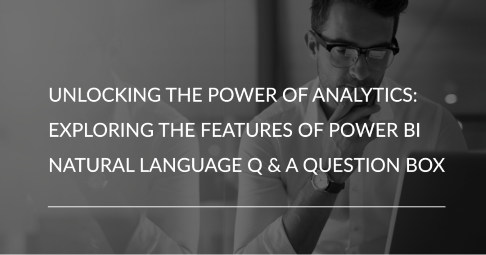
30 June 2023
In an era where data drives business decisions, the power to extract insights from this information is paramount. Power BI, a suite of business analytics tools developed by Microsoft, has been at the forefront of this revolution. One of the key functionalities in Power BI is the Power BI Natural Language Q & A Question Box, a feature designed to make data analysis more intuitive and less time-consuming. But what makes this tool so remarkable? Why is Natural Language Processing (NLP) vital in modern analytics? Let's delve into the subject.
Firstly, what exactly is the Power BI Q & A Question Box? In essence, it's a feature within Power BI that allows users to pose queries about their data in natural, conversational language. You might wonder, why would this be a game-changer? After all, data analysis has been around for years. Well, the primary advantage is user-friendliness. Traditional data analysis methods often require a strong understanding of query languages like SQL. This poses a barrier to non-technical staff who want to retrieve insights from their company's data. The Power BI Q & A Question Box breaks down this barrier, democratising data analysis by making it accessible to everyone.
So, the Power BI Q & A Question Box is a tool that simplifies data querying, but what features does it possess that make it stand out?
In the context of data analysis, NLP refers to a system's ability to understand and respond to human language. It's the force that drives the Power BI Q & A Question Box, allowing users to ask questions about their data as if they were conversing with a human analyst. Imagine being able to ask, "What were the sales figures for last quarter?" and receiving an immediate, accurate answer - that's the power of NLP in Power BI.
Power BI Q & A goes beyond simply providing textual answers. It's designed to create visualisations in real-time based on your queries. For instance, asking "Show me sales trends over the last year" could generate a dynamic line graph, making it easier to comprehend the information.
Power BI Q & A performs real-time data analysis, ensuring you're always working with the most up-to-date information. This real-time responsiveness is crucial for fast-paced business environments where data and situations can change rapidly.
To assist in data querying, the Power BI Q & A feature offers smart suggestions and auto-complete capabilities. As you type your question, the system offers suggestions to complete your query, based on the underlying data and popular queries. This helps to streamline the data analysis process and enhance user experience.
One of the more versatile features of the Power BI Q & A Question Box is its ability to handle a wide range of data types and sources. This includes structured and unstructured data from various databases, Excel spreadsheets, cloud services, and even streaming data.
Now that we've explored the core features, how does one maximise the utility of the Power BI Q & A Question Box? Let's walk through a step-by-step guide:
Review the visualisation or answer generated by the system. You
can refine your question as needed to obtain the desired results.
Let's explore a hypothetical example of the Power BI Q & A Question Box in action. A clothing retailer wants to understand sales patterns to optimise their inventory. Rather than combing through spreadsheets or databases, they simply ask the Q & A Question Box: "What were the top-selling items last summer?" The system immediately provides a chart showing the top-selling items during that period, helping the retailer make data-driven inventory decisions.
Looking ahead, we can anticipate further advancements in Power BI and NLP. Improved natural language understanding will lead to more accurate and context-aware responses from the Q & A Question Box. Moreover, the integration of machine learning could enable the system to learn from past queries, further enhancing its predictive and analytical capabilities.
The Power BI Natural Language Q & A Question Box is a powerful tool that simplifies data analysis. Its core features, such as NLP capabilities, interactive data visualisation, real-time data analysis, smart suggestions and wide compatibility, democratise data access and insights. By effectively utilising this tool, businesses can unlock new depths of understanding from their data, driving informed decision-making and fostering growth.
CONTACT
+44 (0)20 8446 7555
Copyright © 2023 JBI Training. All Rights Reserved.
JB International Training Ltd - Company Registration Number: 08458005
Registered Address: Wohl Enterprise Hub, 2B Redbourne Avenue, London, N3 2BS
Modern Slavery Statement & Corporate Policies | Terms & Conditions | Contact Us